Royal Navy Battleships: HMS Nelson, HMS Rodney, HMS Vanguard
Royal Navy battleships HMS Nelson, HMS Rodney, HMS Vanguard
The Nelson class was a class of two battleships (Nelson and Rodney) of the British Royal Navy, built shortly after, and under the terms of, the Washington Naval Treaty of 1922. They were the only British battleships built between the Revenge class, ordered in 1913, and the King George V class, ordered in 1936.The ships were named after famous British admirals: George Brydges Rodney, 1st Baron Rodney, victor of the Battle of Cape St. Vincent and the Battle of the Saintes, and Horatio Nelson, 1st Viscount Nelson, who won the Battles of the Nile and Trafalgar.To comply with the limitations of the Washington Treaty, these ships were of an unusual design with many novel features. They are often referred to as the first treaty battleships. The Nelsons were unique in British battleship construction, being the only ships to carry a main armament of nine 16-inch (406 mm) guns. The most unusual feature however, and one that is immediately noticeable, is that these were all carried forward of the bridge.Commissioned in 1927–29, the Nelsons served extensively in the Atlantic, Mediterranean, and Indian oceans during World War II. Rodney was made famous by her role in the sinking of the Bismarck in May 1941. At the climax of the battle Rodney, in conjunction with King George V, closed on Bismarck to bombard her at short range. Rodney's main guns were credited with an estimated 100 to 130 hits, contributing greatly to Bismarck's final destruction.Nelson and Rodney participated in the bombardment of targets in northern France during and after D-Day. In particular, during the Caen campaign Nelson was credited with destroying a group of five Tiger tanks which ventured into a red zone [within 40 km (25 mi) of the coast] deemed by the German command to be in range of Allied battleships. Both ships of the class survived the war, but were scrapped in 1948–1949 along with all other British battleships except the four remaining King George V–class battleships and Vanguard. (Wikipedia)
HMS Nelson (28)

(IWM Photo, MH 4)
HMS Nelson (28), 1937.
HMS Nelson(pennant number: 28) was thename ship of her classof two battleships built for theRoyal Navyin the 1920s. They were the first battleships built to meet the limitations of theWashington Naval Treatyof 1922. Entering service in 1927, the ship spent her peacetime career with theAtlanticandHome Fleets, usually as the fleetflagship. During the early stages of the Second World War, she searched for Germancommerce raiders, missed participating in theNorwegian Campaignafter she was badly damaged by aminein late 1939, and escorted convoys in theAtlantic Ocean.In mid-1941Nelsonescorted several convoys to Malta before being torpedoed in September. After repairs she resumed doing so before supporting the British invasion ofFrench AlgeriaduringOperation Torchin late 1942. The ship covered the invasions of Sicily (Operation Husky) and Italy (Operation Avalanche) in mid-1943 while bombarding coastal defences during Operation Baytown. During the Normandy landings in June 1944, Nelson provided naval gunfire support before she struck a mine and spent the rest of the year under repair. The ship was transferred to the Eastern Fleet in mid-1945 and returned home a few months after the Japanese surrender in September to serve as the flagship of the Home Fleet. She became a training ship in early 1946 and was reduced to reservein late 1947. Nelson was scrapped two years later after being used as a target for bomb tests. (Wikipedia)
HMS Rodney
_year_unknown_(50151874546).jpg)
(Royal Navy Photo)
HMS Rodney.
HMS Rodney was one of two Nelson-class battleships built for the Royal Navy in the mid-1920s. The ship entered service in 1928, and spent her peacetime career with the Atlantic and Home Fleets, sometimes serving as a flagship when her sister ship, Nelson, was being refitted. During the early stages of the Second World War, she searched for German commerce raiders, participated in the Norwegian Campaign, and escorted convoys in the Atlantic Ocean. Rodney played a major role in the sinking of the German battleship Bismarck in mid-1941.After a brief refit in the United States, she escorted convoys to Malta and supported the Allied invasion of French Algeria during Operation Torch in late 1942. The ship covered the invasions of Sicily (Operation Husky) and Italy (Operation Baytown) in mid-1943. During the Normandy landings in June 1944, Rodney provided naval gunfire support and continued to do so for several following offensives near the French city of Caen. The ship escorted one convoy through the Arctic to the Soviet Union in late 1944. In poor condition from extremely heavy use and a lack of refits, she was reduced to reserve in late 1945 and was scrapped in 1948. (Wikipedia)
HMS Vanguard (23)
_underway%2C_circa_in_the_late_1940s.jpg)
USN Photo)
HMS Vanguard (23) underway at sea, photographed from the island of a British Illustrious-class aircraft carrier, circa in the late 1940s.
HMS Vanguard was a British fast battleship built during the Second World War and commissioned after the war ended. She was the largest and fastest of the Royal Navy's battleships,[3] and the only ship of her class. Vanguard was the last battleship to be built in history. The Royal Navy anticipated being outnumbered by the combined German and Japanese battleships in the early 1940s, and had therefore started building the Lion-class battleships. However, the time-consuming construction of the triple-16-inch (406 mm) turrets for the Lion class would delay their completion until 1943 at the earliest. The British had enough 15-inch (381 mm) guns and turrets in storage to allow one ship of a modified Lion-class design with four twin-15-inch turrets to be completed faster than the Lion-class vessels that had already been laid down. Work on Vanguard was started and stopped several times during the war, and her design was revised several times during her construction to reflect war experience. These stoppages and changes prevented her from being completed before the end of the war.
Vanguard's first task after completing her sea trial at the end of 1946 was, early the next year, to convey King George VI and his family on the first Royal Tour of South Africa by a reigning monarch.[5] While refitting after her return, she was selected for another Royal Tour of Australia and New Zealand in 1948. This was cancelled due to King George's declining health and Vanguard briefly became flagship of the Mediterranean Fleet in early 1949. After her return home in mid-1949, she became flagship of the Home Fleet Training Squadron. Throughout her career, the battleship usually served as the flagship of any unit to which she was assigned. During the early 1950s, Vanguard was involved in a number of training exercises with NATO forces. In 1953 she participated in Queen Elizabeth II's Coronation Review.
Through the mid-1950s she was kept active, along with four older battleships in reserve, largely as a counter to the Soviet Sverdlov-class cruiser fleet, which she easily outperformed. As the Blackburn Buccaneer attack aircraft entered service, the need for large-gun ships to counter the Sverdlovs ended since the Buccaneer could attack the Sverdlovs with relative ease. While Vanguard was refitting in 1955, the Admiralty announced that the ship was going to be put into reserve upon completion of the work. She was sold for scrap and was broken up beginning in 1960. (Wikipedia)
.jpg)
(RN Photo)
HMS Vanguard underway in 1946.
_underway_c1947.jpg)
(IWM Photo, A A 31247)
HMS Vanguard (23) underway c1947.
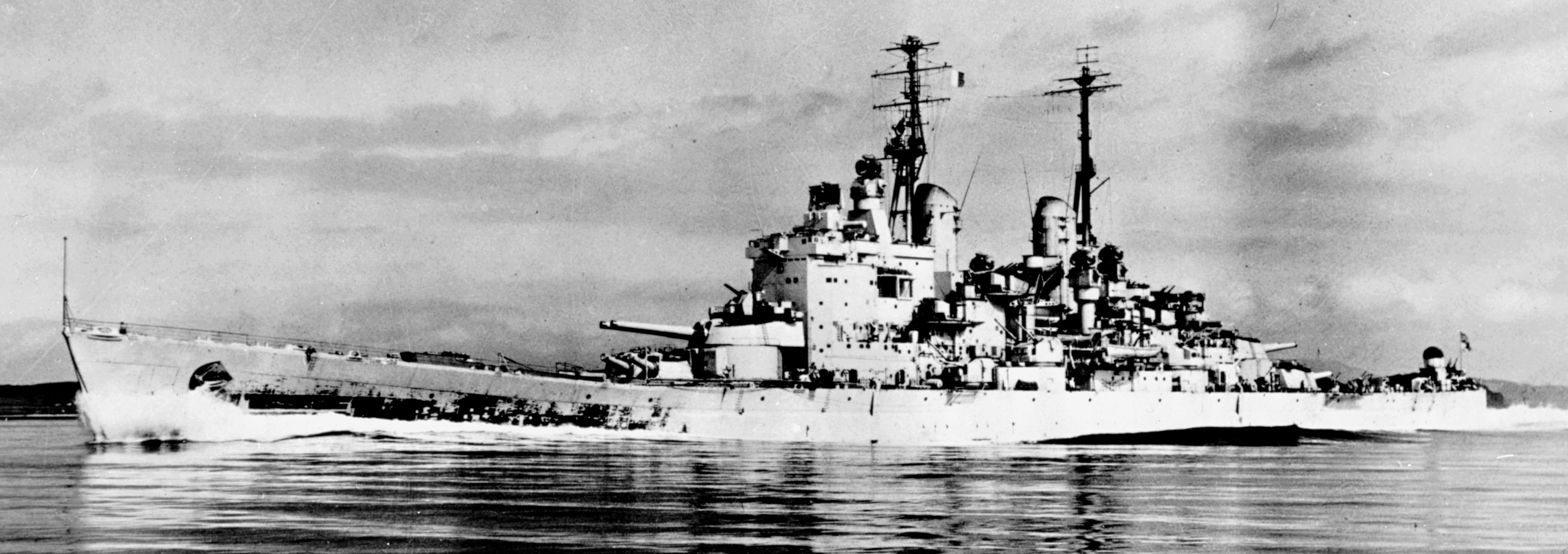
(USN Photo)
HMS Vanguard (23) steaming at high speed while running trials in 1946.
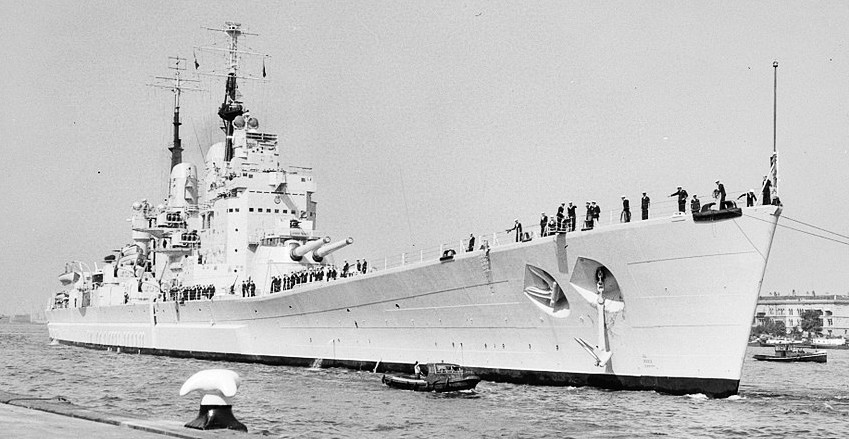
(Nationaal Archief Photo)
HMS Vanguard (23), Rotterdam, Netherlands, 28 June 1952.
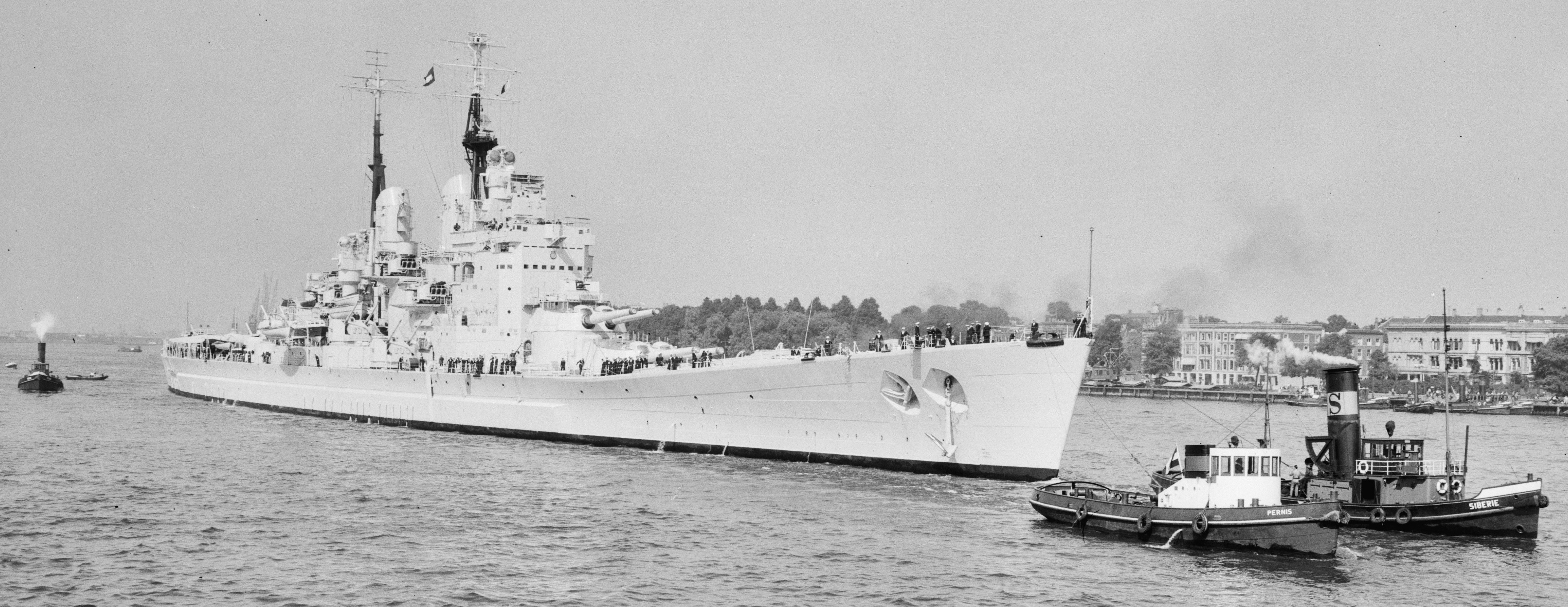
(Nationaal Archief Photo)
HMS Vanguard (23), Rotterdam, Netherlands, 28 June 1952.
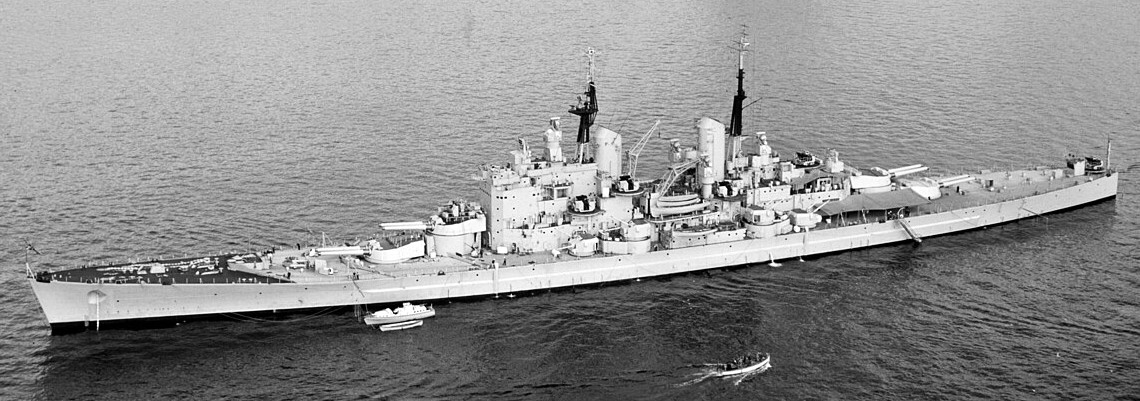
(USN Photo)
HMS Vanguard (23), at anchor in the Firth of Clyde, Scotland (UK), during NATO Operation Mainbrace, September 1952.
.jpg)
(USN Photo)
HMS Vanguard (23) at anchor in the Firth of Clyde, Scotland (UK), during NATO Operation Mainbrace, in September 1952.
1.jpg)
(USN Photo)
Royal Navy battleship HMS Vanguard (23) at anchor in port, with boat booms out and a motor launch alongside.
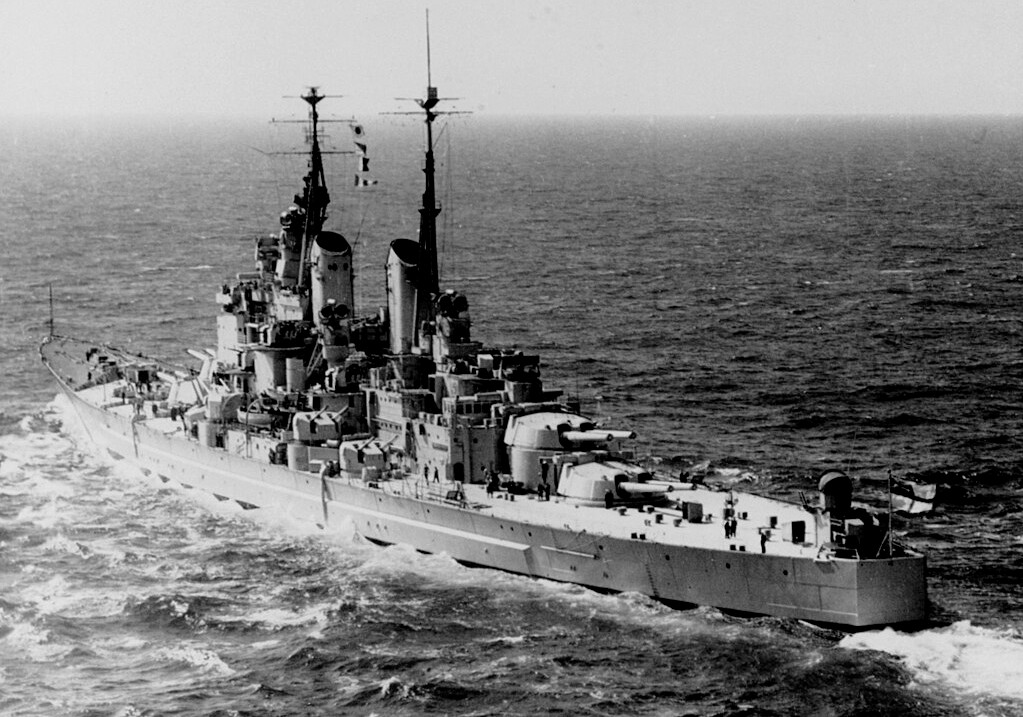
(USN Photo)
Stern quarter view of the Royal Navy battleship HMS Vanguard (23).

(USN Photo)
Overhead view of the Royal Navy battleship HMS Vanguard (23) underway.
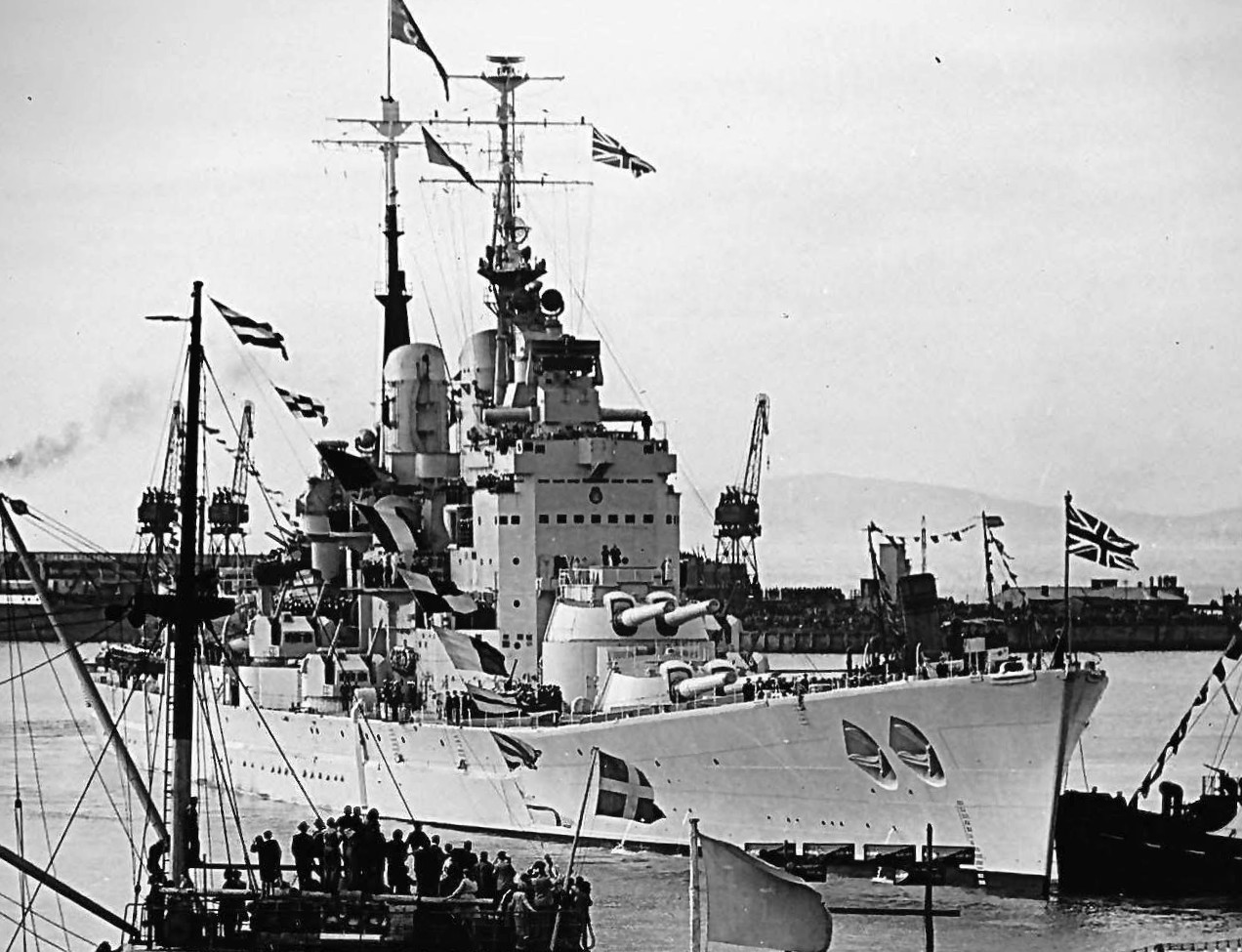
(RN Photo)
HMS Vanguard with the Royal Family aboard arrives at Table Bay Harbour, Cape Town, South Africa on 17 February 1947.

(RN Photo)
During the Royal tour of SA in Feb. 1947, the British King George VI along with Queen Elizabeth and their daughters, Princesses Elizabeth and Margaret, arrived in Cape Town aboard HMS Vanguard.

